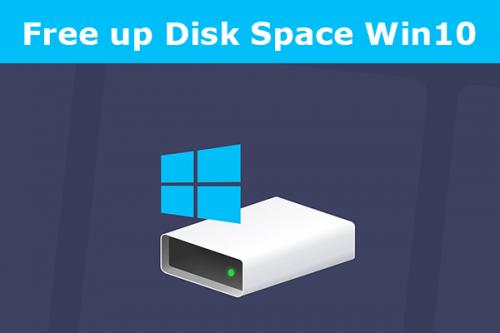How to Free up Drive Space in Windows 10

Have you ever experienced this situation? While installing an important program on your Windows 10 computer, you got an annoying 'low disk space' message, and it stopped everything. It's frustrating, right? Well, not having enough space isn't just a hassle; it can also slow down our computer.
Then, in this situation, how can we install or upload any application, program, or data to it? In this article, we will discuss how we can easily free up drive space in our Windows 10 using methods and caution to prevent data loss in the process as well.
Built-in Methods to Free up Drive Space in Windows 10
We need to free up the space on the hard drive because if we don't do it, our operating system performance will be affected or slow down, and we cannot install or store any more data on it. So to clean up disk space in Windows 10, we can use the following methods:
1. Delete Unwanted Files
The first step in freeing up drive space on our Windows 10 computer is to delete unnecessary files. Here's how to do it:
Open the File Explorer by clicking on the folder icon in the taskbar or by pressing the Windows key + E.
Reach to the folder or drive where you want to delete files, such as "This PC" or "Local Disk (C:)."
Browse through files and identify those you no longer need. Common items for deletion include:
Old documents
Duplicate files
Downloaded files you've already used
Large media files like movies or videos
Right-click on the file or folder you want to delete and select "Delete." Confirm it.
2. Empty the Recycle Bin
When we delete files in Windows, they're not permanently removed but instead sent to the recycle bin. To truly free up space, we have to empty the recycle bin. Here's how:
Reach the Recycle Bin icon on the desktop.
Right-click on the recycle bin and choose "Empty Recycle Bin."
Confirm it.
3. Uninstall Unused Programs
On our computer, we have some software that we no longer use. Uninstalling these programs can free up considerable space. Here's how:
Open the Windows Settings by clicking the Start button and selecting the gear-shaped icon.
Go to "Apps" or "Apps & Features," depending on the Windows version.
Scroll through the list of installed programs and select the ones you want to uninstall.
Click "Uninstall" and follow the on-screen instructions.
4. Disk Cleanup
Windows 10 has a built-in tool called "Disk Cleanup" that can help us remove unnecessary system files. To run Disk Cleanup:
Type "Disk Cleanup" in the Windows search bar and click on the result.
Select the drive you want to clean (usually, this will be the C: drive).
The tool will calculate how much space can be recovered. You can select which file types to clean by checking the boxes. Common options include:
Temporary files
Recycle Bin
System error memory dump files
Click "OK" and then "Delete Files" to confirm your selections.
Caution to Prevent Data Loss During Clean-up Drive Space
While freeing up disk space is necessary, there is still some chance of data loss in this process, which can affect us, but by following the tips written below, we can reduce the chances of data loss:
1. Backup Your Data: Before starting to clean up the drive space, make sure to back up all important files. This way, even if something goes wrong during the cleanup, our data is safe.
2. Double-check Before Deleting: Be very careful when selecting files or programs to delete. Make sure you're not removing anything important for your system to function properly.
3. Use built-in cleanup tools: Windows has tools like Disk Cleanup that are designed to help us clean up our drive safely. Stick to these tools instead of manually deleting files.
4. Keep Important Files Separated: Keep your important documents and files in a separate folder. This way, we can avoid accidentally deleting them during cleanup.
5. Monitor the Cleanup Process: If you're using a cleanup tool, keep an eye on what it's doing. Make sure it's not removing files you want to keep.
Conclusion
In conclusion, managing our computer's storage space doesn't have to be a difficult task. By following these straightforward steps, we can easily free up drive space in Windows 10. Regularly performing these maintenance tasks will not only help us avoid the low disk space warning but also ensure that our computer runs smoothly and efficiently.
We should be cautious while cleaning up the drive space because it contains our precious data, so it is advisable to back up important data on an external drive before applying drive cleaning.
But if you face the situation of data loss, don't worry; we also have a solution. You just have to contact us at Techchef Data Recovery at - 1800-313-1737 and talk to our professionals in data recovery; they will help further in the process of recovering data.
Post Your Ad Here
Comments